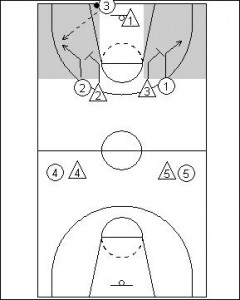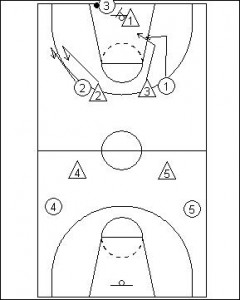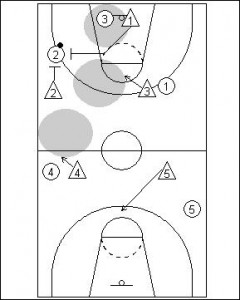1-2-2 Full Court Zone Press Explained
A favourite strategy for coaches trying to turn up the pressure on offensive teams is the 1-2-2 Full Court Zone Press. The zone press is a great option for beginner and elite coaches alike because it gives a very specific position and structure to defensive players. In a zone press each and every player within the team has a specific place and role that can easily be seen and defined when orientated to a position on the floor. This makes the defence far easier to teach then man to man trapping options.
The 1-2-2 Full Court Zone Press is utilised by coaches in a number of situations and for a variety of reasons. This tactic is often used to disrupt the rhythm of the opposition’s offensive transition and half court execution. The application of pressure on ball handlers in the full court in many cases is enough to create and increased rate of turn overs and poor shot selection is often a characteristic of teams playing against this defence. You will see this tactic also used when defensive teams see a weakness in the offences ball handling guards.
For a more detailed analysis around trapping have a look at FBC’s 1-2-2 Halfcourt Press E-Book.
There are a number of strengths to the 1-2-2 Full Court Zone Press. The most obvious is the ability for this type of tactic to be easily explained and taught. Because everyone sets up in an easily identifiable formation defensive players often find this one of the easiest defences to learn. Additionally, because this type of tactic allows the defensive players to be aggressive, intense and control the tempo of the game, it is also one of the more enjoyable strategies for players.
A weakness in all full court pressure defences is the challenge posed by offensive teams if they are able to break the initial trapping situation and move the ball ahead of the majority of defensive players. This is one of the gambles coaches must weigh up when implementing this defence, but to counter this coaches should always emphasis the need for players to recover to behind the ball and into help defence positions. Another problem that can become an issue is if overzealous defensive players are too aggressive which can lead to foul trouble.
If coaching against a team utilising the 1-2-2 Full Court Zone Press it is important to have your players continue to play at the tempo your offence is normally played at. By rushing you are less likely to be able to effectively execute what you need to do in breaking down the press. From the inbound offensive players off the ball need to find space where they can be a passing option for the ball handler. Because of the nature of this defence as a coach you should drill this in training sessions leading up an opponent who utilises this strategy. By doing this you will help minimise player anxiety your offensive players might feel and allow them to deal with the pressure more constructively.

Passive Defence
Athletes sprint on a made basket into position.
The shaded area signifies where the defence wants the offence to receive the ball.
Defenders in the second line of the press (Two and Three) create an opportunity for the lead into the shaded area for the offensive players by being in a closed stance and then release defensive pressure as the offensive players enter the position to receive the ball.
The third line of defenders (Four and Five) move into a position where they are in line with the furtherest offensive players down the court.

Full Denial
Defensive players sprint on made basket into position.
Defenders guarding the ball create an aggressive verbal and physical presence to distract the in bounder.
Defenders in the second line of the press (Two and Three) work hard to deny the offense receiving the ball.
Third line of defenders (Four and Five) move into a position where they are up the passing lane creating a flat triangle between the ball and their defensive assignment. Defenders should be up the lane about a third of the passing distance.

Secondary Trapping
The strong side guard (Two) and the defender in the point position (One) move to form the initial trap.
If the offensive player breaks the trap then the defender who has vision follows the ball.
In this example One (1) would form a secondary trap with Four (4). Two (2) would form a secondary trap with Three (3).
If the offensive player breaks the trap defenders who are one pass away, (Three and Four) move into a position to form a secondary trap.
Shaded areas show possible trapping options.
Want some more information about the 1-2-2 Halfcourt Press? Look at Functional Basketball Coaching’s E-Book, new at the FBC Store!
Related articles






